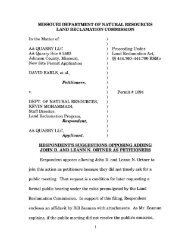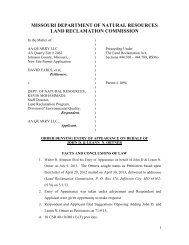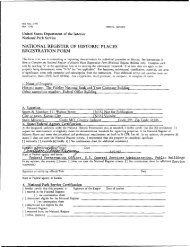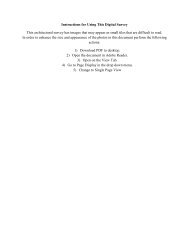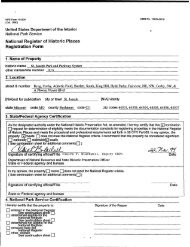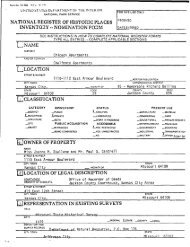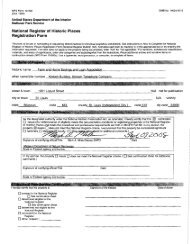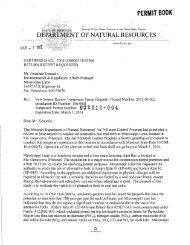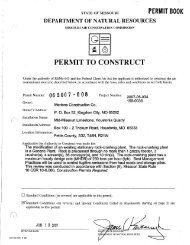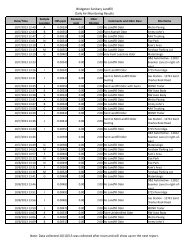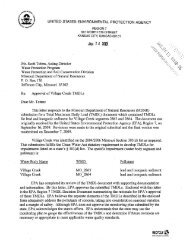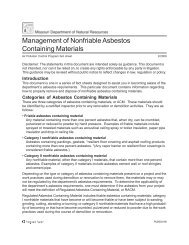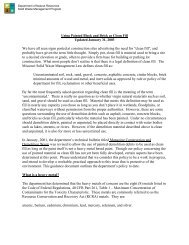Berry Motor Car Service Building - Missouri Department of Natural ...
Berry Motor Car Service Building - Missouri Department of Natural ...
Berry Motor Car Service Building - Missouri Department of Natural ...
You also want an ePaper? Increase the reach of your titles
YUMPU automatically turns print PDFs into web optimized ePapers that Google loves.
NPS Form 10-900-a OMB Approval No. 1024-0018 (8-86)<br />
United States <strong>Department</strong> <strong>of</strong> the Interior<br />
National Park <strong>Service</strong><br />
National Register <strong>of</strong> Historic Places<br />
Continuation Sheet<br />
Section number 8 Page 10 <strong>Berry</strong> <strong>Motor</strong> <strong>Car</strong> <strong>Service</strong> <strong>Building</strong><br />
St. Louis (Independent City), MO<br />
Historic Auto-Related Resources, City <strong>of</strong> St. Louis, 1850-1955<br />
not be purchasing new cars for some time to come. During the war, auto manufacturers issued<br />
publications that encouraged customers to keep their cars well maintained until new automobiles<br />
were again available. After the war, consumer production returned but was seriously stifled due<br />
to materials shortages that continued through the late 1940s. 16 As a result, the automobile service<br />
department became even more important to the dealership’s viability. <strong>Berry</strong>’s construction <strong>of</strong> an<br />
automobile service building in 1937 was visionary; it illustrates his understanding (prior to<br />
wartime rationing) that consumers, though unable to afford new cars, required service and<br />
maintenance.<br />
an effort to regain market control, including Packard, which coupled with<br />
tudebaker in 1954. 18<br />
The post-World War II era was a climate <strong>of</strong> great change for automobile manufacturers.<br />
Although by 1949, America was producing a record number <strong>of</strong> cars and consumer purchases<br />
were up by 40% from 1941, materials shortages continued to plague automakers’ economic<br />
recovery. Additionally, political and economic shifts led to big changes in American auto<br />
manufacturing after World War II. Consumers not only wanted new cars – they demanded more<br />
for their money. Although a few companies (such as Studebaker) introduced radically designed<br />
post-war models, most (including Packard) recycled familiar styles to keep up with production<br />
demands. The new models that did emerge during the 1940s, in combination with superior<br />
production methods developed during and after the war, allowed the “Big Three” (Chrysler,<br />
Ford, and General <strong>Motor</strong>s) to squeeze out what little competition remained. 17 Some independent<br />
companies merged in<br />
S<br />
George <strong>Berry</strong> saw the writing on the wall – the automobile business had changed dramatically<br />
during the years that he was involved. In 1953, he sold his interest in <strong>Berry</strong> <strong>Motor</strong> <strong>Car</strong> Company<br />
to Albrecht-Burke, Inc., which also distributed Packards. <strong>Berry</strong> remained at the company<br />
afterward as treasurer. He died in 1960 at the age <strong>of</strong> 79, preceded by his wife Ann who died in<br />
1939.<br />
pr<strong>of</strong>essional activities. It was constructed under his direction to support the Packard dealership at<br />
19 <strong>Berry</strong>’s charitable and community accomplishments are too numerous to fully recount.<br />
In addition to operating <strong>Berry</strong> <strong>Motor</strong> <strong>Car</strong> Company for more than 30 years, he served as director<br />
<strong>of</strong> United Charities; assisted in founding Boys’ Town <strong>of</strong> <strong>Missouri</strong>; served on the State Welfare<br />
Commission; and was a director <strong>of</strong> the Ways and Means Committee. 20 The <strong>Berry</strong> <strong>Motor</strong> <strong>Car</strong><br />
<strong>Service</strong> <strong>Building</strong> on Washington Avenue is an excellent representation <strong>of</strong> George <strong>Berry</strong>’s<br />
16<br />
Keenoy et al, E:11-12.<br />
17<br />
May, xxi-xxiv.<br />
18<br />
Allen et al, 8:17.<br />
19<br />
“George M. <strong>Berry</strong> Dies; Auto Man,” St. Louis Post-Dispatch (22 January 1960), 3C; <strong>Missouri</strong> State Board <strong>of</strong><br />
Health/Bureau <strong>of</strong> Vital Statistics.<br />
20<br />
<strong>Missouri</strong> Historical Society, 373.



